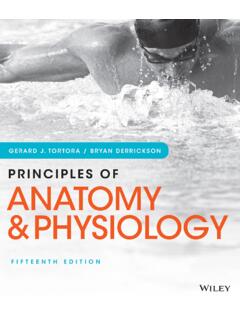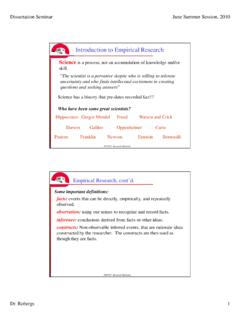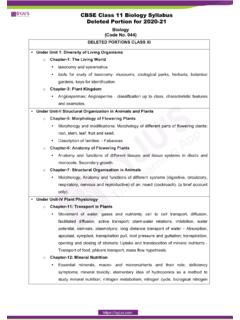Transcription of Medical Physiology 3rd Edition by Walter F. Boron
1 Medical PhysiologyTHIRD EDITIONWALTER F. Boron , MD, PhDProfessorDavid N. and Inez Myers/Antonio Scarpa ChairmanDepartment of Physiology and BiophysicsCase Western Reserve UniversityCleveland, OhioEMILE L. BOULPAEP, MDProfessorDepartment of Cellular and Molecular PhysiologyYale University School of MedicineNew Haven, ConnecticutTable of ContentsInstructions for online accessCover imageTitle PageCopyrightContributorsVideo Table of ContentsPreface to the Third EditionThe eBookAcknowledgmentsPreface to the First EditionTarget AudienceContent of the TextbookEmphasis of the TextbookCreating the TextbookSpecial FeaturesAcknowledgmentsSection I IntroductionChapter 1 Foundations of PhysiologyReferencesSection II Physiology of Cells and MoleculesChapter 2 Functional Organization of the CellStructure of Biological MembranesFunction of Membrane ProteinsCellular Organelles and the CytoskeletonSynthesis and Recycling of Membrane ProteinsSpecialized Cell TypesReferencesChapter 3 Signal TransductionMechanisms of Cellular CommunicationReceptors That are Ion ChannelsReceptors Coupled to G ProteinsReceptors That are CatalyticNuclear ReceptorsReferencesChapter 4
2 Regulation of Gene ExpressionFrom Genes to ProteinsThe Promoter and Regulatory ElementsTranscription FactorsRegulation of Inducible Gene Expression by Signal-Transduction PathwaysEpigenetic Regulation of Gene ExpressionPost-Translational Regulation of Gene ExpressionReferencesGlossaryChapter 5 Transport of Solutes and WaterThe Intracellular and Extracellular FluidsSolute Transport Across Cell MembranesRegulation of Intracellular Ion ConcentrationsWater Transport and the Regulation of Cell VolumeTransport of Solutes and Water Across EpitheliaReferencesChapter 6 Electrophysiology of the Cell MembraneIonic Basis of Membrane PotentialsElectrical Model of a Cell MembraneMolecular Physiology of Ion ChannelsReferencesChapter 7 Electrical Excitability and Action PotentialsMechanisms of Nerve and Muscle Action PotentialsPhysiology of Voltage-Gated Channels and Their RelativesPropagation of Action PotentialsReferencesChapter 8 Synaptic Transmission and the Neuromuscular JunctionMechanisms of Synaptic TransmissionSynaptic Transmission at the Neuromuscular JunctionToxins and Drugs Affecting Synaptic TransmissionReferencesChapter 9 Cellular Physiology of Skeletal, Cardiac.
3 And Smooth MuscleSkeletal MuscleCardiac MuscleSmooth MuscleDiversity among MusclesReferencesSection III The Nervous SystemChapter 10 Organization of the Nervous SystemCells of the Nervous SystemDevelopment of Neurons and Glial CellsSubdivisions of the Nervous SystemReferencesChapter 11 The Neuronal MicroenvironmentCerebrospinal FluidBrain Extracellular SpaceThe Blood-Brain BarrierGlial CellsReferencesChapter 12 Physiology of NeuronsSignal Conduction in DendritesControl of Spiking Patterns in the SomaAxonal ConductionReferencesChapter 13 Synaptic Transmission in the Nervous SystemNeuronal SynapsesNeurotransmitter Systems of the BrainFast Amino Acid Mediated Synapses in the CNSP lasticity of Central SynapsesReferencesChapter 14 The Autonomic Nervous SystemOrganization of the Visceral Control SystemSynaptic Physiology of the Autonomic Nervous SystemCentral Nervous System Control of the VisceraReferencesChapter 15 Sensory TransductionChemoreceptionVisual TransductionVestibular and Auditory Transduction: Hair CellsSomatic Sensory Receptors, Proprioception, and PainReferencesChapter 16 Circuits of the Central Nervous SystemElements of Neural CircuitsSimple, Stereotyped Responses: Spinal Reflex CircuitsRhythmic Activity: Central Pattern GeneratorsSpatial Representations: Sensory and Motor Maps in the BrainTemporal Representations.
4 Time-Measuring CircuitsReferencesSection IV The Cardiovascular SystemChapter 17 Organization of the Cardiovascular SystemElements of the Cardiovascular SystemHemodynamicsHow Blood FlowsOrigins of Pressure in the CirculationHow to Measure Blood Pressure, Blood Flow, and Cardiac VolumesReferencesChapter 18 BloodBlood CompositionBlood ViscosityHemostasis and FibrinolysisReferencesChapter 19 Arteries and VeinsArterial Distribution and Venous Collection SystemsElastic Properties of Blood VesselsReferencesChapter 20 The MicrocirculationCapillary Exchange of SolutesCapillary Exchange of WaterLymphaticsRegulation of the MicrocirculationReferencesChapter 21 Cardiac Electrophysiology and the ElectrocardiogramElectrophysiology of Cardiac CellsThe ElectrocardiogramCardiac ArrhythmiasReferencesChapter 22 The Heart as a PumpThe Cardiac CycleCardiac DynamicsFrom Contractile Filaments to a Regulated PumpReferencesChapter 23 Regulation of Arterial Pressure and Cardiac OutputShort-Term Regulation of Arterial PressureRegulation of Cardiac OutputMatching of Venous Return and Cardiac OutputIntermediate- and
5 Long-Term Control of the CirculationReferencesChapter 24 Special CirculationsThe BrainThe HeartThe Skeletal MuscleThe Splanchnic OrgansThe SkinReferencesChapter 25 Integrated Control of the Cardiovascular SystemInteraction among the Different Cardiovascular Control SystemsResponse to Erect PostureResponses to Acute Emotional StressResponse to ExerciseResponse to HemorrhageReferencesSection V The Respiratory SystemChapter 26 Organization of the Respiratory SystemComparative Physiology of RespirationOrganization of the Respiratory System in HumansLung Volumes and CapacitiesReferencesChapter 27 Mechanics of VentilationStatic Properties of the LungDynamic Properties of the LungReferencesChapter 28 Acid-Base PhysiologypH and BuffersAcid-Base Chemistry When Is the Only BufferAcid-Base Chemistry in the Presence of and Buffers The Davenport DiagrampH Regulation of Intracellular FluidReferencesChapter 29 Transport of Oxygen and Carbon Dioxide in the BloodCarriage of O2 Carriage of CO2 ReferencesChapter 30 Gas Exchange in the LungsDiffusion of GasesDiffusion and Perfusion Limitations on Gas TransportReferencesChapter 31 Ventilation and Perfusion of the LungsVentilationPerfusion of the LungMatching Ventilation and PerfusionReferencesChapter 32 Control of VentilationOverview of the Respiratory Control SystemNeurons That Control VentilationGeneration of the Respiratory RhythmChemical Control of VentilationModulation of Ventilatory ControlReferencesSection VI The Urinary SystemChapter 33 Organization of the Urinary SystemFunctional Anatomy of the KidneyMain Elements of Renal FunctionMeasuring Renal Clearance and TransportThe Ureters and BladderReferencesChapter 34 Glomerular
6 Filtration and Renal Blood FlowGlomerular FiltrationRenal Blood FlowControl of Renal Blood Flow and Glomerular FiltrationReferencesChapter 35 Transport of Sodium and ChlorideNa+ and Cl Transport by Different Segments of The NephronNa+ and Cl , and Water Transport at the Cellular and Molecular LevelRegulation of Na+ and Cl TransportReferencesChapter 36 Transport of Urea, Glucose, Phosphate, Calcium, Magnesium,and Organic SolutesUreaGlucoseOther Organic SolutesPhosphateCalciumMagnesiumReferenc esChapter 37 Transport of PotassiumPotassium Balance and the Overall Renal Handling of PotassiumPotassium Transport by Different Segments of the NephronPotassium Transport at the Cellular and Molecular LevelsRegulation of Renal Potassium ExcretionReferencesChapter 38 Urine Concentration and DilutionWater Balance and the Overall Renal Handling of WaterWater Transport by Different Segments of the NephronGeneration of a Hyperosmotic Medulla and UrineRegulation by Arginine VasopressinReferencesChapter 39 Transport of Acids and BasesAcid-Base Balance and the Overall Renal Handling of AcidAcid-Base Transport by Different Segments of the NephronAcid-Base Transport at the Cellular and Molecular LevelsRegulation of Renal Acid SecretionReferencesChapter 40
7 Integration of Salt and Water BalanceControl of Extracellular Fluid VolumeControl of Water Content (Extracellular Osmolality)ReferencesSection VII The Gastrointestinal SystemChapter 41 Organization of the Gastrointestinal SystemOverview of Digestive ProcessesRegulation of Gastrointestinal FunctionGastrointestinal MotilityReferencesChapter 42 Gastric FunctionFunctional Anatomy of the StomachAcid SecretionPepsinogen SecretionProtection of the Gastric Surface Epithelium and Neutralization of Acid in the DuodenumFilling and Emptying of the StomachReferencesChapter 43 Pancreatic and Salivary GlandsOverview of Exocrine Gland PhysiologyPancreatic Acinar CellPancreatic Duct CellComposition, Function, and Control of Pancreatic SecretionSalivary Acinar CellSalivary Duct CellComposition, Function, and Control of Salivary SecretionReferencesChapter 44 Intestinal Fluid and Electrolyte MovementFunctional AnatomyOverview of Fluid and Electrolyte Movement in the IntestinesCellular Mechanisms of Na+ AbsorptionCellular Mechanisms of Cl Absorption and SecretionCellular Mechanisms of K+ Absorption and SecretionRegulation of Intestinal Ion TransportReferencesChapter 45 Nutrient Digestion and AbsorptionCarbohydrate DigestionCarbohydrate AbsorptionProtein DigestionProtein, Peptide, and Amino-Acid AbsorptionLipid DigestionLipid AbsorptionDigestion and Absorption of Vitamins and MineralsNutritional RequirementsReferencesChapter 46 Hepatobiliary FunctionOverview of Liver PhysiologyFunctional Anatomy of the Liver and Biliary TreeUptake, Processing.
8 And Secretion of Compounds by HepatocytesBile FormationEnterohepatic Circulation of Bile AcidsThe Liver as a Metabolic OrganReferencesSection VIII The Endocrine SystemChapter 47 Organization of Endocrine ControlPrinciples of Endocrine FunctionPeptide HormonesAmine HormonesSteroid and Thyroid HormonesReferencesChapter 48 Endocrine Regulation of Growth and Body MassGrowth HormoneGrowth-Promoting HormonesRegulation of Body MassReferencesChapter 49 The Thyroid GlandSynthesis of Thyroid HormonesAction of Thyroid HormonesHypothalamic-Pituitary-Thyroid AxisReferencesChapter 50 The Adrenal GlandThe Adrenal Cortex: CortisolThe Adrenal Cortex: AldosteroneThe Adrenal MedullaReferencesChapter 51 The Endocrine PancreasInsulinGlucagonSomatostatinRefer encesChapter 52 The Parathyroid Glands and Vitamin DCalcium and Phosphate BalancePhysiology of BoneParathyroid HormoneVitamin DCalcitonin and Other HormonesReferencesSection IX The Reproductive SystemChapter 53 Sexual DifferentiationGenetic Aspects of Sexual DifferentiationDifferentiation of the GonadsDevelopment of the Accessory Sex OrgansDifferentiation of the External GenitaliaEndocrine and Paracrine Control of Sexual DifferentiationPubertyReferencesChapter 54 The Male Reproductive SystemHypothalamic-Pituitary-Gonadal AxisTestosteroneBiology of Spermatogenesis and SemenMale Sex ActReferencesChapter 55 The Female Reproductive SystemHypothalamic-Pituitary-Gonadal Axis and Control of the Menstrual CycleOvarian SteroidsThe Ovarian
9 Cycle: Folliculogenesis, Ovulation, and Formation of the Corpus LuteumThe Endometrial CycleFemale Sex ActMenopauseReferencesChapter 56 Fertilization, Pregnancy, and LactationTransport of Gametes and FertilizationImplantation of the Developing EmbryoPhysiology of the PlacentaThe Maternal-Placental-Fetal UnitResponse of the Mother to PregnancyParturitionLactationReferencesC hapter 57 Fetal and Neonatal PhysiologyBiology of Fetal GrowthDevelopment and Maturation of the Cardiopulmonary SystemCardiopulmonary Adjustments at BirthNeonatal PhysiologyReferencesSection X Physiology of Everyday LifeChapter 58 MetabolismForms of EnergyEnergy BalanceEnergy Interconversion From Cycling between 6-Carbon and 3-Carbon MoleculesEnergy Capture (Anabolism)Energy Liberation (Catabolism)Integrative Metabolism During FastingReferencesChapter 59 Regulation of Body TemperatureHeat and Temperature: Advantages of HomeothermyModes of Heat TransferActive Regulation of Body Temperature by the Central Nervous SystemHypothermia, Hyperthermia, and FeverReferencesChapter 60 Exercise Physiology and Sports ScienceMotor Units and Muscle FunctionConversion of Chemical Energy to Mechanical WorkMuscle FatigueDeterminants of Maximal O2 Uptake and ConsumptionSweatingEndurance (Aerobic) TrainingReferencesChapter 61 Environmental PhysiologyThe EnvironmentDiving PhysiologyHigh-Altitude PhysiologyFlight and Space PhysiologyReferencesChapter 62 The Physiology of AgingConcepts in AgingCellular and Molecular Mechanisms of AgingAging of the Human Physiological SystemsAging SlowlyReferencesIndexCopyright1600 John F.
10 Kennedy 1800 Philadelphia, PA 19103-2899 Medical Physiology , THIRD EDITIONISBN: 978-1-4557-4377-3 INTERNATIONAL EDITIONISBN: 978-0-323-42796-8 Copyright 2017 by Elsevier, Inc. All rights part of this publication may be reproduced or transmitted in anyform or by any means, electronic or mechanical, including photocopying,recording, or any informatio







